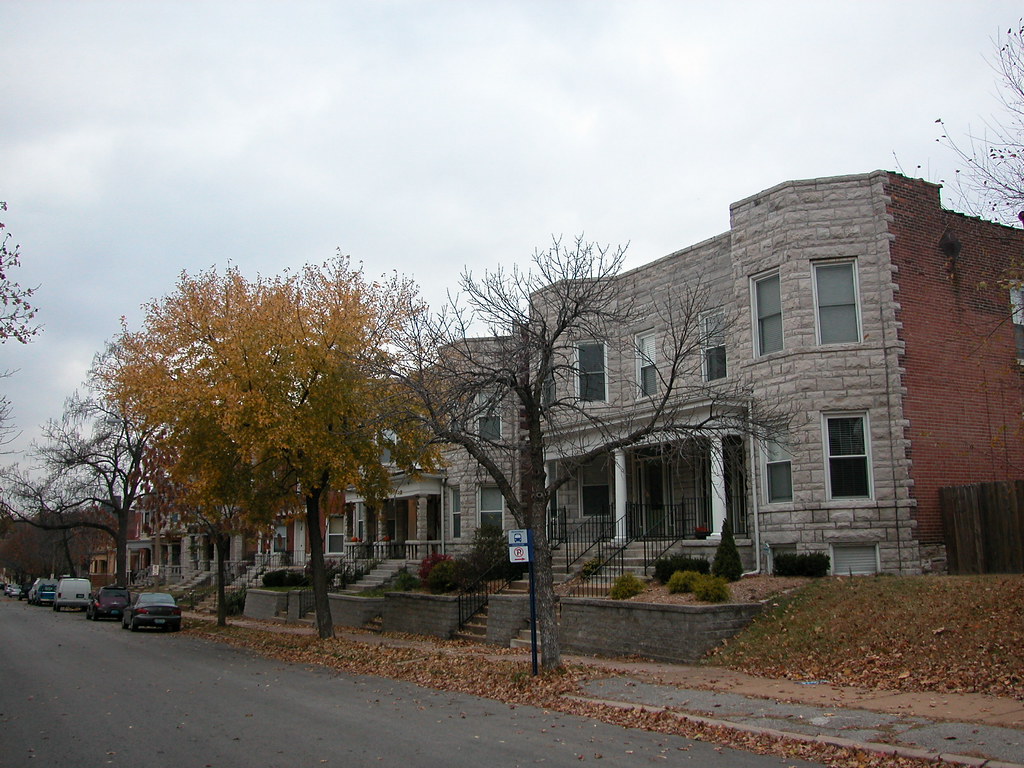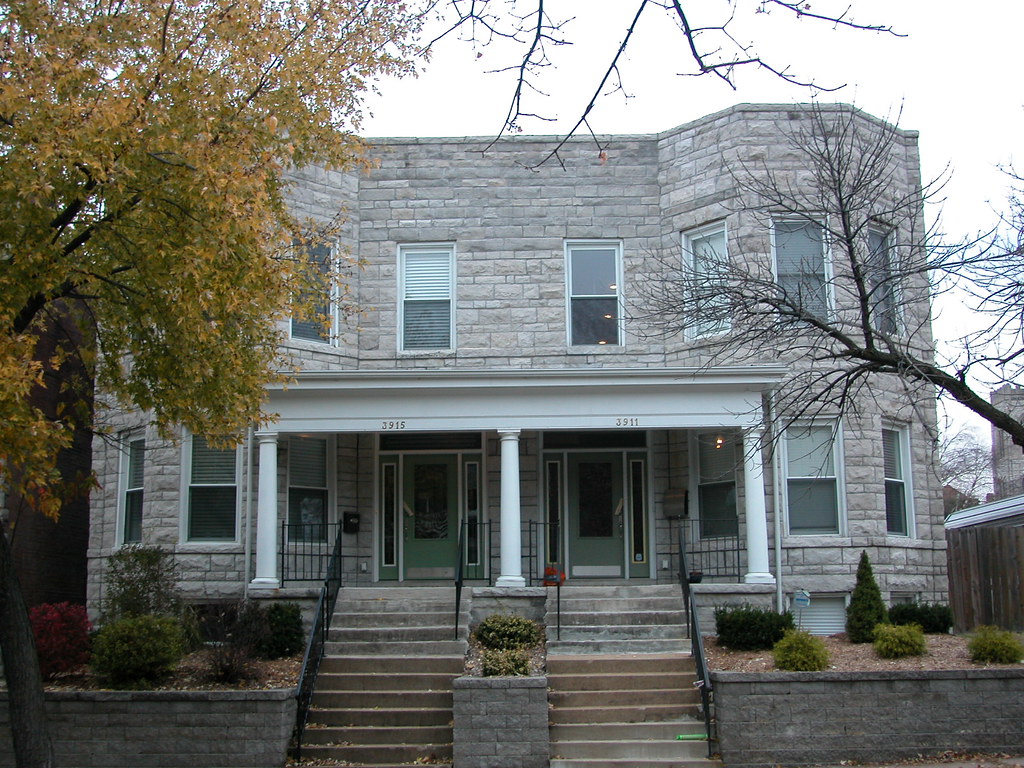 The 2007 fire that struck the four-flat at 3927-29 Shenandoah Avenue in the Shaw neighborhood eventually proved fatal. The building had been under rehabilitation when fire struck. The owners stopped paying taxes and mortgage payments, and ownership somehow split between Heartland Bank and the Land Reutilization Authority (the building straddles a lot line).
The 2007 fire that struck the four-flat at 3927-29 Shenandoah Avenue in the Shaw neighborhood eventually proved fatal. The building had been under rehabilitation when fire struck. The owners stopped paying taxes and mortgage payments, and ownership somehow split between Heartland Bank and the Land Reutilization Authority (the building straddles a lot line).Obviously, the building was struck severely by the fire. Like most house fires, the fire spread upward and consumed the roof and second floor worst. Most of the roof sheathing was lost in the fire, leaving the building open to the elements. However, the walls had been tuckpointed and remained solid until the last days.
In October 2008, the Building Division condemned the building for demolition and sought demolition. Neighbors had filed many complaints on the condition of the house. Immediately to the west, a developer is rehabbing a similar building using historic rehab tax credits and understandably did not want a big question-mark next door.
After first being placed on the November 2008 agenda of the Preservation Board, the demolition shifted into high gear. Suddenly, the Building Division issued an emergency demolition order and paid to wreck the building. By the middle of December, it was gone. (Wonder if owner Heartland Bank got a bill for half of the cost?)
While the condition of the building was extreme, it was far from being a total loss. With solid masonry, the building was in no danger of immediate collapse. This could have been a great reconstruction project. Instead, the house went through the motions of our failed public safety laws: damage and abandonment, citizen complaints, emergency tear-down order. As the developers next door show, there is more than one way to fix a broken building, but the Building Division never seems to grasp that fact. Nor does the Cultural Resources Office (CRO) possess sufficient legal authority to prevent a senseless demolition like this one; the office and the Preservation Board were at the mercy of the Building Division, which controls what matters reach consideration of our preservation agency and its citizen commission. The CRO cannot override an emergency order, no matter how silly it is (and many are).
The neighbors' momentary complaints are addressed, but they ultimately lose a remarkable street scape. On a block with only two gaps in continuous historic building line, both across the street, this demolition stands out. The demolition stands out even more since the demolished house is one of a row of five near-copies of the same plan built in 1903. defined by rusticated limestone front elevations, central porches and projecting bays on each end, the row was a handsome group.

Looking at one of the extant members of this group, one sees the potential that the house at 3927-29 Shenandoah Avenue had, even in its fire-damaged state.

Demolition matters as much in a neighborhood as dense as Shaw as it does in a ravaged built environment like Old North. I would write that the only difference is why the buildings matter, but that would be false. The reason senseless demolitions harm our neighborhoods is because they erode the sense of place. Take away the last two buildings on a north side block, and the last vestige of the block's urban character is gone forever. Take away one house on an intact block face in Shaw, and that block face is no longer intact. That brings a difference as big as taking down the last building standing. Besides, it's not just a matter of blocks or neighborhoods but ultimately a matter of stewardship of this interconnected mass of resources we call St. Louis.





7 comments:
Huh-low!
Save the facade! New Orleans does it all the time! This town is simply unbelievable! How can this process be changed?!
Like I said before, it's like knocking out a tooth. First it's just one, and it looks really bad; then one day you wake up and your mouth is empty.
DC and Baltimore save facades all the time too, and to great effect.
I live in Shaw and I do find it troubling whenever something like this happens. When new buildings are put up on lots like this, no matter how nice of a home is built, they never really match the historic character of the neighborhood.
Of course, one of the problems now is finding someone willing to invest in a burned out historic building. A few years ago when the market was really on fire it might have been easier to expect someone to step up and be willing to rehab something like this.
Unfortunately, now that building would likely have stayed empty and abandoned for a very long time. Buildings like that invite vagrancy, drugs and other crime onto that block.
Shaw has steadily been improving in the 10 years we have lived here and part of that can be attributed to the number of abandoned buildings that have either been rehabbed or torn down. It is a conundrum - let beautiful historic buildings sit empty until someone comes along and takes care of them thus inviting crime, or tear them down in order to remove the blight.
Ooor, you could do like Baltimore and DC do (I've seen it) and mothball the buildings. This is just negligence on the part of the owner(s) and the City. Frankly, considering the speed at which this structure came down, I wouldn't be surprised if their weren't some, ahem, "understanding" between the Building Div. and the owners(s). Not to mention the demo company. This town is corrupt, and this demolition is an indication of that. Certainly everyone remembers that three employees of the Building were indicted on taking kickbacks (or was it an out and out bribe, can't remember). Don't be so naive, folks. It's so unbecoming of otherwise intelligent and self-aware psople. As for the nabe folks, do you really think that tearing down this building will stop or curtail drug activity in your nieghbohood? You're starting down a dangerous and destructive path: blaming the building for the actions of its' occupants or owners. Look to the northside for the aftermath of 35 years of this misbegotten and uninformed attitude. If you want a better way of ultimately destroying your neighborhood, I don't think you'll find one. Death of a nabe by a thousand cuts. Or demolitons, as the case may be. "Well, it's just this one building." And then another, and another... A building was torn down on Juniata near Louisiana back in '07, and it too had sustained some fire damage, though it appearred to be minimal and confined to the kitchen area in one unit. Now it's a vacant lot. How many other "fires" are going to occur on the southside now that the norhtside is largely hollowed out? The demo cos. are running out of mines to gather brick, where do you think they're going to go? Where the buildings are, that's where: the southside. Fortunately, with the recession in full swing, the demand for "antique" bricks is probably waaay down. Nobody building McMansions in Houston or Atlanta featuring St. Louis brick. I know, a little tin-foil hat-ish, but these demos don't make sense most of the time.
One of the properties owners across the street from this property is a client of mine. I actually came by the day after the fire. My client told me that the now former owner was in over his head when residential rehab prices started to slip and he was losing everything. She admitted that she had snuck into the house after the fire department left and that there were obvious signs that someone had spread some sort of accelerant all over the house. I don't know if anything official ever happened, but sounded like a textbook case of arson for insurance money. The shell was totally salvageable though. What a shame.
This is right down the street from me, and while it is currently a bit of an eye-sore, demolishing it would be terrible, there is already another vacant lot on Shenandoah a bit further West toward Grand.
Post a Comment